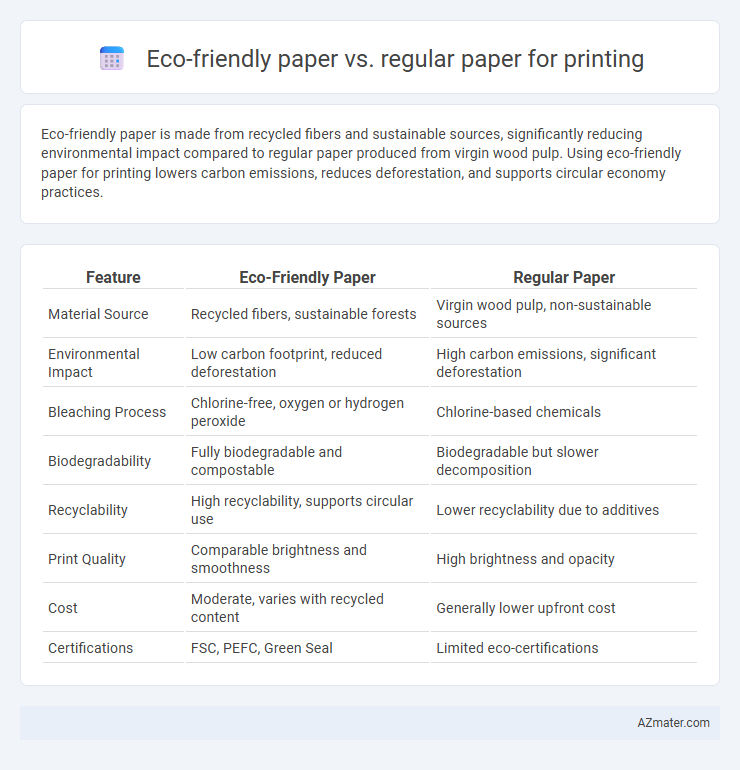Eco-friendly paper is made from recycled fibers and sustainable sources, significantly reducing environmental impact compared to regular paper produced from virgin wood pulp. Using eco-friendly paper for printing lowers carbon emissions, reduces deforestation, and supports circular economy practices.
Table of Comparison
| Feature | Eco-Friendly Paper | Regular Paper |
|---|---|---|
| Material Source | Recycled fibers, sustainable forests | Virgin wood pulp, non-sustainable sources |
| Environmental Impact | Low carbon footprint, reduced deforestation | High carbon emissions, significant deforestation |
| Bleaching Process | Chlorine-free, oxygen or hydrogen peroxide | Chlorine-based chemicals |
| Biodegradability | Fully biodegradable and compostable | Biodegradable but slower decomposition |
| Recyclability | High recyclability, supports circular use | Lower recyclability due to additives |
| Print Quality | Comparable brightness and smoothness | High brightness and opacity |
| Cost | Moderate, varies with recycled content | Generally lower upfront cost |
| Certifications | FSC, PEFC, Green Seal | Limited eco-certifications |
Introduction to Paper Types: Eco-Friendly vs Regular
Eco-friendly paper is typically made from recycled materials or sustainable sources, reducing deforestation and lowering carbon emissions compared to regular paper derived from virgin wood pulp. It often incorporates chlorine-free bleaching and uses less water and energy during production, enhancing its environmental advantages. Regular paper, while widely used, contributes significantly to environmental degradation due to intensive resource consumption and chemical treatments.
What Makes Paper Eco-Friendly?
Eco-friendly paper is made from recycled fibers or sustainably sourced materials, reducing deforestation and minimizing environmental impact. It often uses chlorine-free bleaching processes and lower energy consumption during production, contributing to lower carbon footprints. Compared to regular paper, eco-friendly options support biodiversity preservation and promote responsible forest management through certifications like FSC or PEFC.
Environmental Impact: Production Processes
Eco-friendly paper production uses sustainable raw materials such as recycled fibers or fast-growing trees, significantly reducing deforestation and habitat loss compared to conventional paper made from old-growth forests. The manufacturing process of eco-friendly paper typically involves fewer chemicals and consumes less water and energy, resulting in lower greenhouse gas emissions. In contrast, regular paper production often relies on intensive bleaching and chemical treatments that contribute to water pollution and higher carbon footprints.
Resource Consumption: Water, Energy, and Raw Materials
Eco-friendly paper production significantly reduces water consumption by up to 60% compared to regular paper, utilizing recycled fibers and sustainable forestry practices. Energy usage in eco-friendly paper manufacturing is lowered by 30-50% due to efficient processing techniques and renewable energy sources. The dependence on virgin raw materials decreases, as eco-friendly paper incorporates post-consumer waste and sustainably sourced wood pulp, minimizing deforestation and ecological impact.
Chemical Usage and Pollution Comparison
Eco-friendly paper utilizes fewer harmful chemicals during production, significantly reducing the release of chlorine and other toxic substances compared to regular paper. Conventional paper manufacturing often involves bleaching with chlorine-based agents, contributing to water pollution and the formation of dioxins, which are hazardous environmental pollutants. Choosing eco-friendly paper supports sustainable forestry practices and minimizes chemical waste, leading to lower overall environmental impact in printing processes.
Print Quality and Performance Differences
Eco-friendly paper for printing often features recycled fibers and sustainable sourcing, which can impact print quality by producing slightly duller colors and less sharp text compared to regular paper made from virgin pulp. Performance differences include a higher likelihood of paper jams and slower drying times due to variations in coating and texture. However, advancements in eco-friendly paper technology are continually improving its compatibility with high-resolution printing and durability in various printing processes.
Cost Analysis: Short-term and Long-term
Eco-friendly paper for printing often incurs higher short-term costs due to sustainable sourcing and manufacturing processes, but it reduces environmental impact and aligns with corporate social responsibility goals. Over the long term, using eco-friendly paper can decrease waste disposal costs and attract environmentally conscious clients, potentially increasing brand loyalty and profitability. Regular paper typically offers lower immediate expenses but may lead to higher environmental compliance costs and reputational risks over time.
Recycling and End-of-Life Disposal
Eco-friendly paper is designed with recycled fibers and biodegradable materials, significantly reducing environmental impact compared to regular paper, which often contains virgin fibers and chemical additives. Recycling eco-friendly paper improves resource efficiency by minimizing landfill waste and lowering greenhouse gas emissions during decomposition. Proper end-of-life disposal of eco-friendly paper ensures compostability or easier recycling, whereas regular paper may contribute to pollution and longer degradation times in landfills.
Certification and Standards for Eco-Friendly Paper
Eco-friendly paper for printing often holds certifications such as FSC (Forest Stewardship Council), PEFC (Programme for the Endorsement of Forest Certification), and Ecolabel, which ensure responsible forest management and reduced environmental impact. These standards verify that the paper is produced using sustainable practices, recycled content, or chlorine-free bleaching processes. In contrast, regular paper typically lacks these certifications, contributing more significantly to deforestation and pollution due to less regulated manufacturing methods.
Choosing the Right Paper for Sustainable Printing
Eco-friendly paper, made from recycled fibers or sustainably sourced materials, reduces environmental impact by minimizing deforestation and lowering carbon emissions compared to regular paper produced from virgin pulp. Choosing eco-friendly paper for printing not only supports sustainable forestry practices but also often involves chlorine-free bleaching processes, resulting in less chemical pollution. For businesses aiming to enhance their eco-conscious branding and reduce their carbon footprint, selecting FSC-certified or 100% post-consumer recycled paper is a strategic decision for sustainable printing solutions.

Infographic: Eco-friendly paper vs Regular paper for Printing
 azmater.com
azmater.com